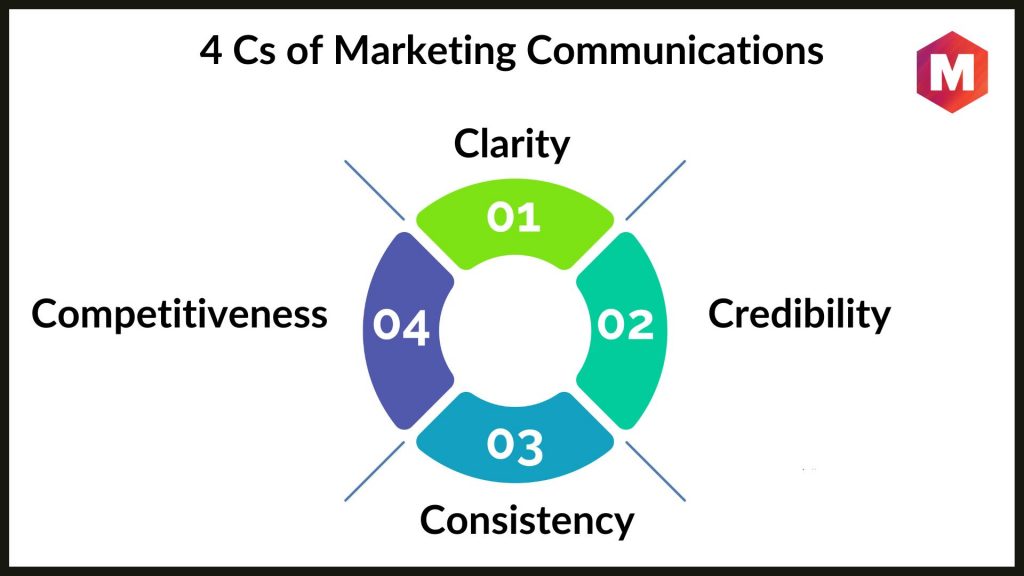The 4 Cs of marketing (customer, cost, convenience, and communication) are a modern, customer-oriented version of the traditional 4 Ps (product, price, place, and promotion).
Bob Lauterborn, a marketing consultant, declared the 4 Ps of the marketing mix, or seller-oriented marketing theory, dead in 1990, stating that instead of using the 4 Ps of marketing, businesses should employ the 4 C’s.
The 4 Cs of business marketing shift the emphasis away from producers to potential customers, providing a better template for companies that service a niche market. In contrast to Jerry McCarthy and Phil Kotler’s 4 P approach, this approach, as the name implies, focuses on providing customers with greater value.
Table of Contents
What are the 4 Cs of Marketing?
The 4 Cs of marketing are the marketing mix that allows a brand or business to survive in the market for a long and acquire a position in the minds of the target audiences by paying attention to the 4 Cs: customer, cost, convenience, and communication.
Customers and marketers must think like customers while using the 4 Cs method. Unlike mass marketing, which was based on the 4 Ps, the 4 Cs marketing idea focuses on niche marketing. By understanding your consumers, you will, in turn, optimize your targeting strategies and increase conversions.
Let us now have a look at the 4 C’s in marketing, one by one:
1. Customer Wants and Needs
The 4 C’s of marketing begin with the consumer’s wants and needs. It all starts with the customer and their wants and needs. You need to understand what they are looking for to create a product or service they will want to buy.
With so many products and services available, standing out in the market can be tough. However, success comes from niching down and finding your customers’ needs. By fulfilling their problems, you’ll build loyalty and Trust—the two foundations of any strong business relationship!
The logic is that creating a product or brand to meet current client needs is a superior technique to creating demand than simply making goods or brands and then seeking for or creating demand for it.
A practical strategy is to follow the “Inverted Pyramid” approach, which asserts that a company’s product development should begin with customer needs and work backward toward increasing market share.
According to this concept, planning and production must be organized in order. First, marketers need to utilize market research via industry-specific consumer surveys, website data insights, etc. to find out what the brand’s existing or potential consumers want or need.
2. Cost
After you have determined what your customers want or need, the next step is to find a way to provide it at a cost that is reasonable for both you and them.
You need to be able to cover the costs of your good or service while also making a profit. This can be done by looking at your production costs, marketing expenses, and overheads.
Once you have a clear understanding of all these costs, you can set a price that will allow you to profit while still being competitive in the market.
It’s important to understand that the 4 C’s of marketing are not just about making money. They are also about creating value for your customers. If you can provide them with a good or service that meets their needs at a fair cost, then you will be able to build a strong relationship with them.
3. Convenience
In today’s fast-paced world, convenience is key. Customers want products and services that are easy to access and use. This means you need to have a distribution strategy that will allow your customers to find and purchase your products or services easily.
This can be done through brick-and-mortar stores, online retailers, or a combination. You need to ensure that your products or services are available where your customers are looking for them.
It’s no secret that people can be lazy. Why go to the store and battle the crowds when you can get what you need with a few clicks of a button right from your living room couch? That’s why Amazon is so popular- the prices are affordable, and it saves people the hassle of going out.
If the interface is too complicated, many consumers will abandon websites. Convenience, as you may infer, has a wide range of characteristics.
4. Communication
The final C in the 4 C’s of marketing is communication. This is how you will get the word out about your product or service. It would help if you had a marketing strategy that will allow you to reach your target audience and communicate the value of your product or service.
There are various ways to do this, including advertising, public relations, and social media. You need to find the method that best suits your product or service and use it to reach your target market.
In the past, companies used different marketing techniques to force customers into purchasing their products. However, in today’s society, where everything is displayed online for the world to see, this no longer works.
Advertisers must consider what consumers want and need before creating a commercial or running an advertising campaign. Only then will they be successful in achieving their goals.
The best-case scenario for communication in marketing is when it happens both ways. You contact your potential customer and use follow-up methods to see if they’re interested. Something as simple as measuring web traffic or ad responses can give you an idea of how well your campaign is doing.
How to Use the 4 Cs Marketing Model?
Remember that the 4 C’s of marketing are not a step-by-step guide.
They are a framework you can use to ensure that you are taking all the necessary steps to create a successful marketing strategy.
You need to find the right mix of all 4 C’s to create a campaign to reach your target market and help you achieve your desired results.
When used correctly, the 4 C’s of marketing can be a powerful tool in your arsenal. By taking the time to understand and implement them, you will be well on your way to achieving your marketing goals.
Some of the ways of applying the 4 Cs of marketing are:
1. Conduct market research to determine what consumers want or need.
2. Find a way to provide the product or service at a reasonable cost.
3. Make sure the product or service is available where customers want it.
4. Use marketing to reach the target audience and communicate the product or service’s value.
5. Measure the results of your marketing campaign and make changes as needed.
The 4 C’s of marketing are a framework for ensuring that your marketing strategy takes all the necessary steps to reach your target market.
You can create a successful campaign by conducting market research, finding a way to provide your product or service at a reasonable cost, making sure it’s available where customers are looking for it, and using marketing to reach your target audience.
Benefits of 4 Cs Marketing Models
The 4 C’s model is a more consumer-based perspective that focuses on understanding your audience’s needs and how best to satisfy them. In a digital world where customer satisfaction and value are paramount, this model provides an online value proposition that is pivotal to your marketing efforts.
These benefits can be summarized as follows:
1. Enhances customer satisfaction by prioritizing their needs and wants.
2. Increases sales by providing value to the customer, which encourages repeat purchases and loyalty.
3. Allows for better marketing allocation by focusing on channels and methods that deliver the most value to the customer.
4. Facilitates customer feedback, which can be utilized to improve the product or service offering further.
5. Boosts the consumer’s shopping experience by integrating technologies such as mobile apps, making the purchasing process more convenient and user-friendly.
4 C’s vs. 4 P’s of Marketing Strategies
The 4 Cs of marketing are a newer framework created to better address the needs of consumers in today’s market.
Conversely, the 4 Ps of marketing campaigns refer to a more traditional framework that focuses on the company’s needs.
The 4 P’s of marketing (product, price, place, and promotion) is a framework created to help companies market their products and services. It’s a more company-centric approach that doesn’t consider the needs of the consumer.
On the other hand, the 4 Cs of marketing are a framework created with the consumer in mind. It focuses on the customer’s needs and how to best meet those needs.
Let us understand the difference between every element of both of these marketing mixes on the grounds of their significance in the marketing world-
1. Customer vs. Product: The four Cs of marketing start with the customer and their wants and needs. The four Ps of marketing, on the other hand, start with the product.
2. Cost vs Price: The total cost is how much the company costs to produce the product or provide the service. Price is how much the customer will pay for the product or service.
3. Convenience vs Place: Convenience is about making it easy for customers to find and use the product or service. The place ensures the product or service is available where the customer wants it.
4. Communication vs. Promotion: Communication is about creating a two-way dialogue with the customer. Promotion is about one-way communication in which the company promotes its product or service.
Overall, 4 Cs are customer-centric models, while 4 Ps are company-centric models.
4 Cs of Marketing Communications
The 4 C’s of the marketing communications framework, while not as well-known as the original 4 C’s, can still be incredibly useful for marketers whose responsibilities include planning, evaluating, or executing communications. These 4 cs are-
1. Clarity
The first C is clarity. Your marketing communications must be clear to be effective in selling products. This means that they should be easy to understand and free of ambiguity, as customers prefer clear communication.
2. Credibility
The second C is credibility. If you want your target audience to take your marketing communications seriously, they must be credible.
3. Consistency
The third C is consistency. If you want your marketing communications to achieve their objectives, they must be consistent and channel promptly with the rest of your marketing mix.
4. Competitiveness
The fourth and final C is competitiveness. Your marketing communications will only be effective if they can stand out among the other marketing materials your target audience already sees.
The 4 Cs of marketing communications are a framework that can help you create more effective marketing communications.
By keeping your message clear, credible, consistent, and competitive, you can increase your target audience’s likelihood of paying attention to your message and taking action.
Conclusion!
By taking into account the 4 Cs, organizations can create a marketing mix tailored to their specific needs and target consumers’ needs. In today’s advertising age, people prefer to shop online, making it very important for organizations to focus on their online presence.
From a small business to a big one, the 4 Cs of marketing play an important role in understanding consumer needs and how to satisfy them. By using the 4 Cs, businesses can create a marketing strategy that will help them reach their target consumers and retain them as loyal customers.
FAQs
What are the 4 Cs of Marketing?
The four Cs of marketing are Consumer, Cost, Communication, and Convenience. Together, they form a customer-oriented marketing strategy that focuses on satisfying consumer needs and wants.
How do the 4 Cs differ from the 4 Ps?
While the four Ps (product, price, place, and promotion) focus on the seller’s perspective, the four Cs approach looks from the buyer’s perspective, focusing on Consumer, Cost, Communication, and Convenience.
Why are the 4 Cs important in online marketing?
The 4 Cs guide businesses in crafting a customer-centric online strategy, considering consumer preferences, cost considerations, effective communication, and convenience in the online shopping experience.
How can a business apply the 4 Cs to retain customers?
Businesses can use the 4 Cs to build customer loyalty by understanding and satisfying customer needs (Consumer), pricing competitively (Cost), effectively communicating their value proposition (Communication), and making their products and services readily accessible (Convenience).
Also read – The 4 Ps of Marketing
Also Read – The 7 Ps of Marketing
Liked this post? Check out the complete series on Marketing





Please cite the original author who wrote about the 4Cs – Robert F Lauterborn:
Robert F. Lauterborn is the James L. Knight Professor of Advertising in the School of Journalism and Mass Communication at University of North Carolina at Chapel Hill
can you send me daily updates about marketing
Please subscribe to the Email from the Email subscription box. Thanks.
can u provide objective questions on marketing..from every topics…
We are trying to do it as fast as we can.
plss update us ..when u have done that…
I need an update on marketing please, especially how I can be creative in forecasting sale and making huge sale in a service oriented firm. Thanks